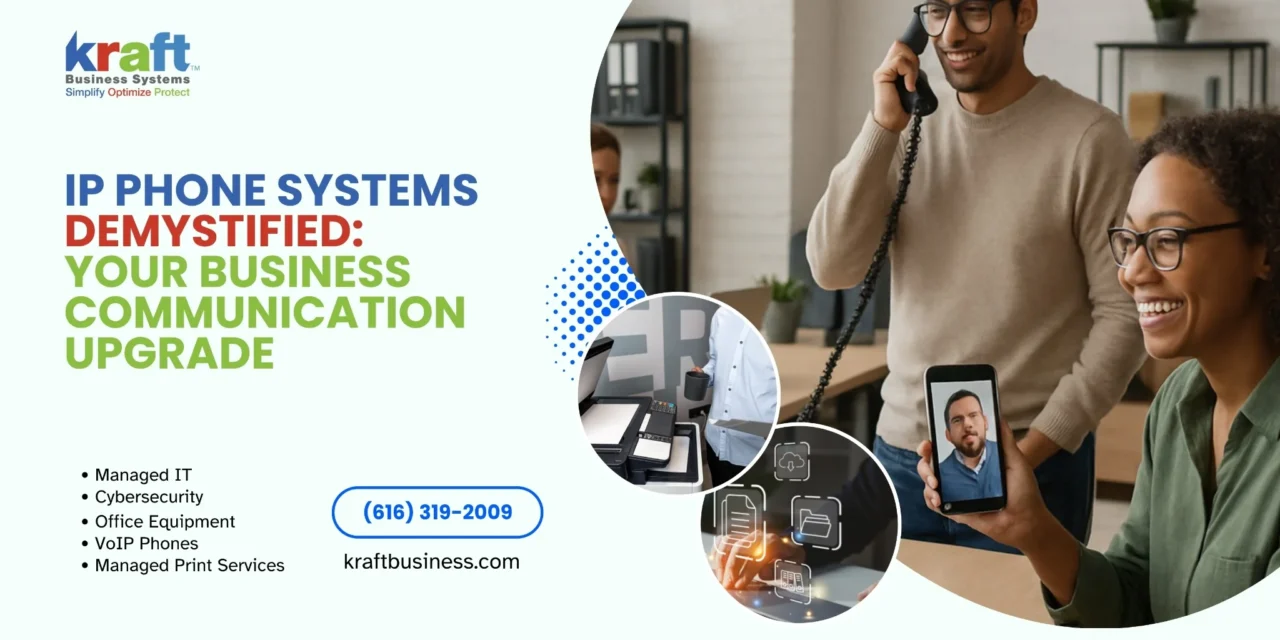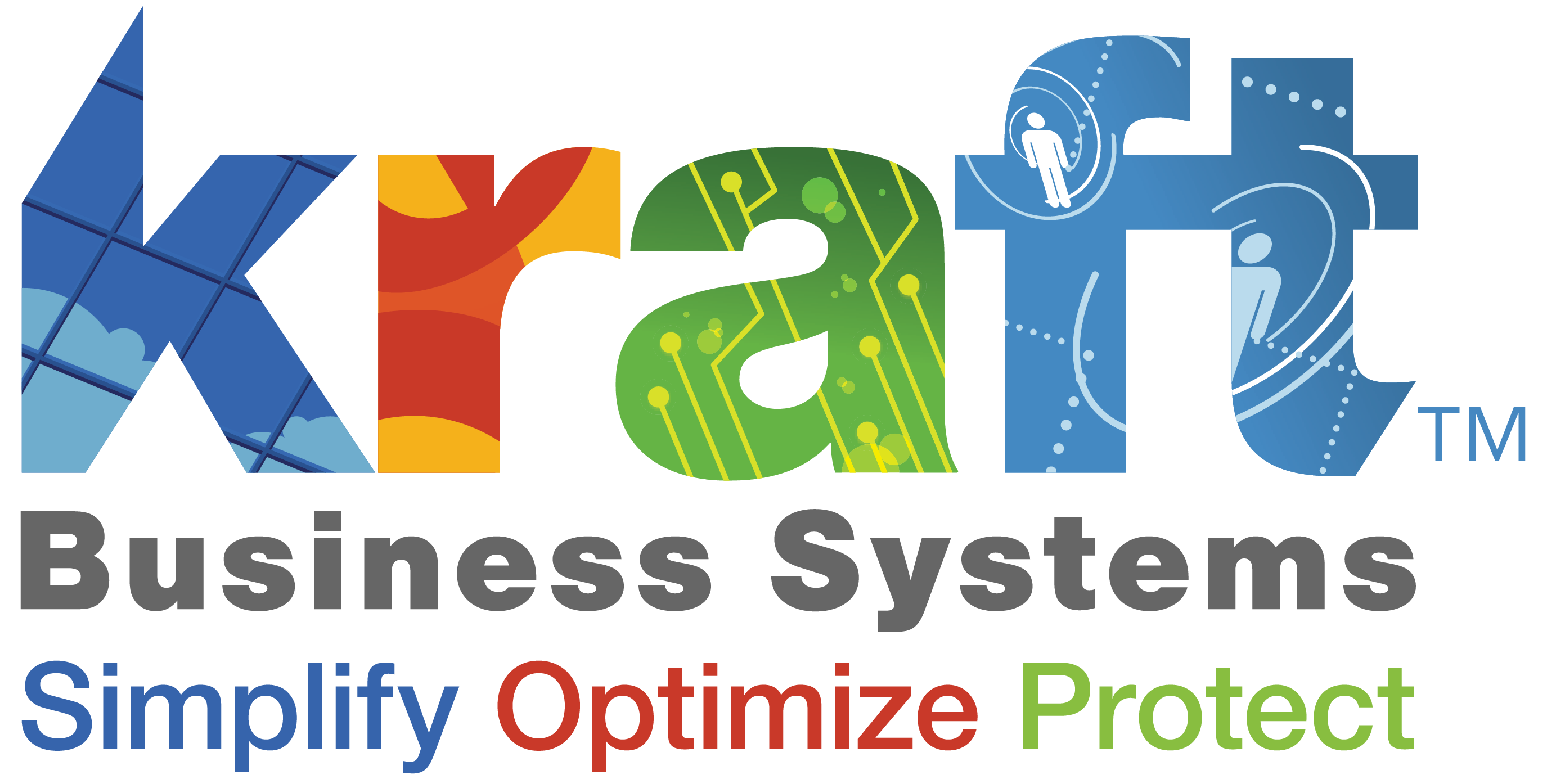An IP phone system is a business communication solution that uses Voice over Internet Protocol (VoIP) technology to make and receive calls over your internet connection instead of traditional phone lines. Here’s what you need to know:
Key Components:
- IP phones – Physical devices or software applications that connect to the internet
- IP PBX – The system that manages call routing and features
- Internet connection – Replaces traditional copper phone lines
- VoIP protocols – Handle call setup, transmission, and termination
How it works:
- Converts your voice into digital data packets
- Sends packets over your internet connection
- Reassembles packets back into voice at the destination
Business communications have evolved dramatically. Traditional phone systems relied on expensive copper wiring and circuit-switched networks. Modern IP phone systems leverage your existing internet infrastructure to deliver superior features at lower costs.
The shift from analog to digital isn’t just about technology – it’s about changing how your team communicates. Remote work, video conferencing, and mobile integration are no longer luxuries. They’re essential tools for staying competitive.
As one industry expert noted: “VoIP phone systems are no longer just for large enterprises; they’re now affordable for organizations of any size.”
Whether you’re running a small office or managing a distributed workforce, understanding IP phone systems helps you make informed decisions about your communication infrastructure. The technology eliminates geographical barriers while providing enterprise-grade features that scale with your business.
Basic ip phone system glossary:
What Is an IP Phone System? A Business VoIP Overview
How VoIP Technology Powers Modern Communication
When you speak into an IP phone system, your voice becomes compressed digital packets that race across the internet and re-form as clear audio on the other end. This packet-switched approach replaces the costly circuit-switched PSTN, letting many calls share one connection and cutting expenses.
Specialised codecs shrink each packet, while Session Initiation Protocol (SIP) sets up, manages and ends every call. The IP PBX (on-site or cloud-hosted) acts as mission control: routing calls, linking to SIP trunks for public network access and delivering voicemail, auto-attendant and analytics.
IP Phones vs. Traditional Phones
| Aspect | IP Phone Systems | Traditional Phone Systems |
|---|---|---|
| Technology | Internet-based (VoIP) | PSTN copper lines |
| Hardware | IP phones, softphones | Analog phones, PBX hardware |
| Scalability | Add users in software | Install physical lines |
| Features | Video, voicemail-to-email, mobile apps | Basic calling |
| Cost | Lower long-distance & maintenance | Higher recurring fees |
| Flexibility | Use anywhere with internet | Tied to location |
Firms routinely save up to 60 % after switching because there are no distance charges and far less hardware. See the numbers in Company Phone Systems.
The Role of SIP and IP PBX
SIP is the universal language that lets assorted desk phones, softphones and conference units work together, avoiding vendor lock-in. Your IP PBX – whether on a local server or in the cloud – becomes the brain that:
- connects internal extensions
- hands calls to the public network
- enforces voicemail, auto-attendant and recording rules
- generates usage reports
Dive deeper with IP PBX and SIP Trunking and explore carrier choices in SIP Trunk Providers.
What Is an IP Phone System? A Business VoIP Overview
The Transformative Benefits of an IP Phone System for Your Business
Switching to an IP phone system reshapes collaboration while lowering costs.
- Reliability: Modern fibre and cable links often outperform ageing copper lines; add redundant circuits for extra protection.
- Scalability: Add or remove users in minutes—no new wiring required.
- Savings: Eliminate line rental, long-distance fees and hefty PBX maintenance.
- Unified communications: Voice, video, chat and email live in a single platform, so staff spend less time switching apps.
Releaseing Mobility and Supporting Remote Work
Softphone apps turn laptops, tablets and smartphones into full business extensions. Calls can ring multiple devices, and you can move an active call from desk phone to mobile without callers noticing. A consistent company number keeps branding intact wherever employees answer. Learn more in Business Hosted Voice.
Advanced Features Out of the Box
- Voicemail-to-email (with optional transcription)
- Call recording for training or compliance
- 24/7 auto-attendant
- Integrated video meetings
- CRM screen-pops when customers call
- Call analytics for staffing insight
Everything You Need to Know About Voice Over Internet Protocol lists even more options that come standard with VoIP.
Exploring the Hardware and Software of IP Telephony
Modern platforms let you mix and match hardware and software so every employee gets the interface that suits them. VoIP Phones for Business compares available models.
Hardware vs. Software: Picking the Right Phone
- Desk Phones – familiar handsets such as the Z-22G IP Phone for everyday users or the feature-rich Zip 45G IP Phone for reception and sales.
- Conference Phones – specialised speakers and microphones that keep voices clear in meeting rooms.
- Cordless DECT Phones – roam warehouses or shop floors without dropping calls.
- Softphones – Windows, macOS, iOS or Android apps that mirror the office extension. Devices like the Zip 49GA Smart Media Phone blur the line between desk and mobile.
Accessories That Boost Productivity
- Wireless headsets for hands-free comfort
- Expansion modules such as the Zip 47GE IP Phone for one-touch keys
- Power over Ethernet (PoE) switches for single-cable installs
- Wall mounts for tight or public spaces
Providing tools people prefer speeds adoption and open ups the full value of your new system.
Setting Up Your System: Key Compatibility and Deployment Factors
Voice shares the same network as your data, so preparation is critical. Allocate about 1 Mbps per simultaneous HD call, keep latency below 150 ms, and configure Quality of Service (QoS) so large downloads never disrupt conversations. Encrypt signalling and media, and harden firewalls to protect privacy.
On-Premise vs. Cloud-Based VoIP
| Choice | Best For | Key Points |
|---|---|---|
| On-premise IP PBX | Businesses that demand full control and have IT staff | One-time hardware cost, extensive customisation, self-managed updates |
| Cloud-hosted PBX | Teams that want simplicity and fast scaling | Monthly per-user fee covers hardware, maintenance and support |
Compare both paths in VoIP Server Provider and Cloud-Based VoIP. Larger deployments can still enjoy cloud convenience—see Cloud-Based Enterprise Phone Systems.
Other Planning Essentials
- Redundant internet links for fail-over
- SIP-compatible phones and gateways
- Integration tests with email, CRM and collaboration suites
- Security best practices from Secure Business Communications
Thorough planning ensures day-one call quality and long-term reliability, whether you operate from Grand Rapids, Lansing or any other Michigan location Kraft Business Systems serves.
Frequently Asked Questions about IP Phone Systems
What is the difference between VoIP and SIP?
Picture VoIP and SIP as partners in a well-choreographed dance. VoIP (Voice over Internet Protocol) is the broad technology that makes it possible to send your voice conversations over the internet instead of traditional phone lines. It’s like the stage where the performance happens.
SIP (Session Initiation Protocol) is more specific – it’s the choreographer that tells everyone when to start dancing, how to move together, and when to take a bow. SIP handles the behind-the-scenes work of setting up your calls, managing them while you’re talking, and cleanly ending them when you hang up.
Here’s why this matters for your business: SIP’s standardized approach means you’re not stuck with one vendor forever. You can mix and match different IP phone system components from various manufacturers, giving you the freedom to choose what works best for your team and budget.
Think of it this way – VoIP is the concept of making calls over the internet, while SIP is the universal language that makes it all work smoothly together.
Can I keep my existing phone number when I switch?
Absolutely! You can keep your existing business phone numbers when you switch to an IP phone system. This process is called Local Number Portability (LNP), and it’s designed to make your transition seamless.
The number porting process typically takes 7-14 business days and involves your new VoIP provider working directly with your current phone company to transfer your numbers. You won’t need to update business cards, websites, or tell customers about new numbers.
Here’s what you can port: toll-free numbers move easily between providers, local business numbers transfer smoothly to VoIP services, and you can even port multiple numbers at once to avoid any confusion during the transition.
Your VoIP provider handles the technical heavy lifting, but you’ll need to provide authorization and some account details from your current provider. The key is timing – keep your existing service active until the port is complete to avoid any gaps in service.
Most businesses find the porting process straightforward, and the ability to maintain established phone numbers removes one of the biggest barriers to upgrading their communication systems.
What kind of internet connection do I need?
Your internet connection is the highway that carries your voice calls, so it needs to be reliable and fast enough to handle the traffic. The good news is that most modern business internet connections can support an IP phone system with some planning.
The basic requirements include at least 1 Mbps of dedicated bandwidth for each person who might be on a call at the same time. If you have five people who could all be talking simultaneously, plan for at least 5 Mbps just for phone calls. You’ll also need low latency (under 150 milliseconds) and minimal packet loss to ensure clear conversations.
Business-grade fiber optic service provides the best experience, offering consistent speeds and reliability. Cable broadband with business-class service works well for most organizations, while DSL connections can work if they provide sufficient upload bandwidth – remember, your voice needs to travel both directions!
Smart businesses often set up redundant connections for backup. Nothing’s worse than losing phone service because your internet goes down. Quality of Service (QoS) configuration helps too, making sure your voice calls get priority over other internet traffic like file downloads or video streaming.
Before making the switch, test your current internet connection during busy periods. This helps identify any potential issues and ensures your team will have crystal-clear conversations from day one.
Upgrade Your Communications with an Expert Partner
The journey from traditional phone systems to modern IP phone systems represents more than just swapping out hardware – it’s about changing how your business connects with customers and empowers your team. The evidence speaks for itself: businesses consistently save up to 60% on communication costs while gaining access to enterprise-grade features that were once reserved for Fortune 500 companies.
Think about what this means for your daily operations. Your receptionist can seamlessly transfer calls to remote workers who appear to be in the office. Your sales team can access customer information instantly when calls arrive. Your support staff can record calls for training without expensive equipment. These aren’t futuristic possibilities – they’re standard features of modern IP telephony.
The scalability factor becomes particularly compelling as your business evolves. Whether you’re adding your first remote employee or opening a second location, IP systems adapt without the headaches of traditional phone installations. No more waiting weeks for the phone company to install new lines or paying hefty fees for simple changes.
Remote work capabilities have shifted from nice-to-have to business-critical. An IP phone system enables your team to maintain professional communication standards regardless of location. Your customers won’t know whether your employee is answering from the office, home, or a coffee shop – and that consistency builds trust.
The reliability improvements often surprise business owners. While internet-based calling might seem less dependable than traditional lines, properly configured IP systems with quality internet connections frequently outperform aging copper networks. Add redundant internet connections, and you’ve got a communication system that’s more resilient than what you’re probably using now.
VoIP Phone System for Small Office Guide walks through the specific considerations that matter most to growing businesses.
The team at Kraft Business Systems understands that communication systems aren’t just about technology – they’re about keeping your business running smoothly. Our Grand Rapids-based consultants and industry experts have helped businesses across Michigan find how IP phone systems can solve real operational challenges.
We’ve seen how the right communication tools can transform customer service, boost productivity, and simplify business operations. Our approach focuses on understanding your specific needs rather than pushing one-size-fits-all solutions. Every business has unique communication patterns, and your system should reflect that reality.
Whether you’re a small office in Traverse City looking to support your first remote worker or a growing company in Ann Arbor planning expansion, we provide the technical expertise and ongoing support that makes IP phone system deployment successful. Our diverse team combines innovative technology solutions with practical business understanding.
The transition doesn’t have to be overwhelming. We guide you through every step, from initial planning through full deployment and beyond. Our goal is ensuring your new system improves your business operations rather than disrupting them.
Contact us today to learn more about our business hosted voice services and find how an IP phone system can transform your business communications. Whether you’re ready to make the switch or just beginning to explore your options, we’re here to help you steer the path to better business communications.










